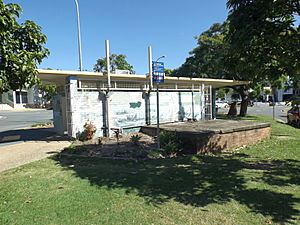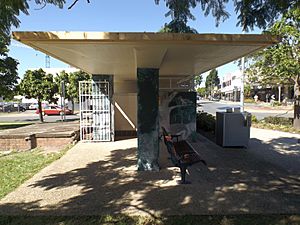Nundah Air Raid Shelter facts for kids
Quick facts for kids Nundah Air Raid Shelter |
|
|---|---|

Structure in 2015
|
|
| Location | Sandgate Road, Nundah, City of Brisbane, Queensland, Australia |
| Design period | 1939 – 1945 (World War II) |
| Built | c. 1942 |
| Architect | Frank Gibson Costello |
| Official name: Nundah Air Raid Shelter | |
| Type | state heritage (built) |
| Designated | 6 April 2005 |
| Reference no. | 602484 |
| Significant period | 1942 (fabric) 1940s (historical) |
| Builders | Brisbane City Council |
| Lua error in Module:Location_map at line 420: attempt to index field 'wikibase' (a nil value). | |
The Nundah Air Raid Shelter is a special building in Nundah, Australia. It was built during World War II to protect people from air attacks. Today, it is used as public toilets. The Brisbane City Council built it around 1942, and Frank Gibson Costello designed it. This shelter is now a heritage-listed site, meaning it's an important part of history.
Contents
Why Air Raid Shelters Were Built
Australia Joins World War II
On December 7, 1941, the United States joined World War II. This happened after Japan attacked the American fleet at Pearl Harbor in Hawaii. The war, which had started in 1939, now became truly global.
Japanese forces bombed Darwin in Australia in February 1942. Many Australians were also captured when Singapore fell. Because of these events, Australia quickly prepared for a possible Japanese invasion.
Brisbane's Role in the War
Queensland became an important base for the war in the Pacific. Many Australian and American soldiers came to Queensland. They needed new buildings and facilities quickly.
Brisbane was the biggest city in Queensland. It was also the most northern major city in Australia. This made it a key target for bombing. Military leaders like General Douglas MacArthur and General Sir Thomas Blamey set up their headquarters in Brisbane. Protecting the people of Brisbane from air raids became very important.
Building Shelters for Safety
Building materials and skilled workers were in high demand. Military projects were given first priority. Large anti-aircraft guns were set up around Brisbane. Coastal guns were also placed on nearby islands.
The Brisbane City Council was in charge of Air Raid Precautions. This included setting up air raid wardens and firefighting systems. They also built many air raid shelters. Saltwater pipes were laid in city streets to help fight fires.
On Christmas Eve, 1941, all Australian states were told to start building shelters. People built trenches in parks and schoolyards. They taped up windows and dimmed lights at night.
Types of Air Raid Shelters
Public Shelters in Brisbane
The government ordered the Brisbane City Council to build 200 public shelters. Work started quickly in December 1941. Later, 75 more shelters were ordered. In the end, 235 air raid shelters were built. Most were finished by June 1942.
The Council also built long covered trenches in public parks. These trenches could hold many people. Shelters were also built at wharves and other important council properties.
Costello's Clever Designs
Frank Gibson Costello was the City Architect for Brisbane from 1941 to 1952. He designed the surface air raid shelters. He had a clever idea: design shelters that could be used for something else after the war.
Costello wanted to avoid having useless concrete buildings everywhere. He planned for some shelters to become bus stops or park shelters. This way, they would still be useful. His designs used modern ideas, focusing on simple shapes and strong materials like concrete.
Reusable Shelter Designs
Costello designed three main types of reusable shelters:
- "Park" Type Shelters: These had four central pillars holding up the roof. The walls could be removed after the war. This would leave an open shelter for parks. Many of these were built, and some are still used as park shelters today. The Nundah shelter is one of these "park" types.
- "Bus" Type Shelters: These were designed so that three of their walls could be removed. This would leave a back wall and front pillars, perfect for a bus stop. Only a few of these still exist.
- "Bus (Stone)" Type Shelters: Similar to the "bus" type, but with a stone back wall and stone pillars. Only one of these remains today.
What Happened After the War
Most of the buildings made for the war were removed when World War II ended. Saltwater pipes, trenches, and sirens disappeared. Many standard shelters in the city were also taken down.
However, 20 of Costello's 58 reusable public shelters survived. Their walls were removed as planned, giving them a new purpose. The Nundah Air Raid Shelter is a great example of this. Its blast walls were removed, and it was turned into public toilets. You can still see where the original walls were.
What the Nundah Shelter Looks Like Now
The Nundah air raid shelter is a rectangular concrete building. It stands on a small grassy area. It has a flat roof supported by concrete pillars.
Today, two-thirds of the shelter are public toilets. These areas are enclosed by concrete block walls. There is a colorful mural painted on the outside walls. The floor inside the toilets is tiled. Outside, there's a timber seat. Skylights have been added to the roof to let in light.
Why It's a Heritage Site
The Nundah Air Raid Shelter is listed on the Queensland Heritage Register. This means it's important for several reasons:
- It Shows History: It helps us understand how Queensland prepared for World War II. It shows the impact of the war on everyday people in Brisbane.
- It's Rare: Many air raid shelters were built, but only a few have survived. This makes the Nundah shelter quite special.
- It Shows Key Features: Its strong concrete build and location near people show what a typical World War II public air raid shelter was like.
- It Shows Clever Design: The shelter was designed to be reused, which was very innovative for its time. It's a good example of how concrete technology was used during the war.
- It's Linked to Important People: It's an example of the work done by the City Architect's Office during the war, especially the designs by F.G. Costello.


